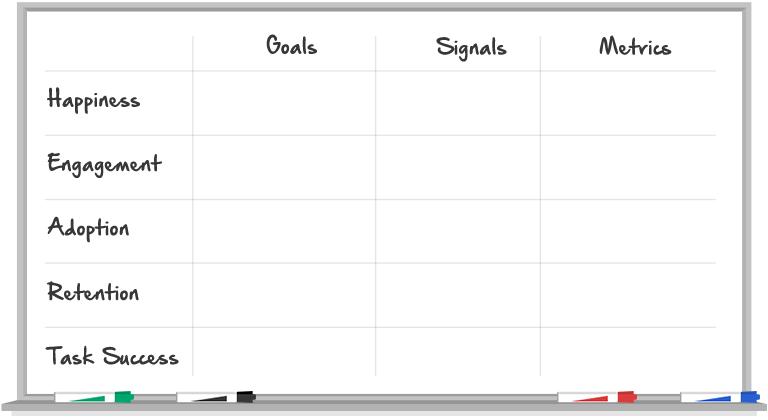Choosing the right user experience (UX) metrics can be challenging. To make truly data-driven and user-centered decisions, it’s critical to first understand your product’s success goals, and then funnel in the best metrics set to track those goals. Building the UX measurement plan is strategic and thoughtful.
Enter Google’s HEART framework.
What is HEART? And How to Use it.
Google’s HEART Framework helps measure the quality of user experience (UX) by setting up goals to measure key performance indicators (KPIs)1. Before determining what metrics to measure, the first step is to determine which categories or KPIs make up the UX-focus for your project or product feature. Below are the 5 categories to help you narrow down your product or project’s UX goals1:
- Happiness: Measures a user’s subjective attitude, such as satisfaction, ease of use, or referral likelihood. These are often collected via survey tools.
- Engagement: Measures how “involved” a user is, such as the frequency or strength of interaction over time.
- Adoption: Measures the number of new users, purchases, or conversions over a time period.
- Retention: Measures the rate at which users return to your site or application, such as repeat purchases, site visits, portal logins, etc.
- Task Success: Measures how efficient and effective your solution is, such as error rates, search result success, and time to upload.
Once you’ve chosen the categories that are the focus for your project, it’s time to figure out which metrics to track. That starts with determining Goals. Google developed a process to help move from goals to meaningful metrics within each category – called Goals > Signals > Metrics2:
- Goals: Different members of your team often have different goals. It’s important to work together to ensure stakeholders agree on the product’s ultimate goal or goals for success.
- Signals: What are the key predictors that will impact a goal? The signals should move only with a change (positive or negative) in user experience.
- Metrics: Stay focused on the outlining key metrics that are closely related to your goals.
You’ll end up with a framework that looks like this:

Following the Goals > Signals > Metrics process will result in a prioritized list of UX metrics to track on a dashboard.
How We Applied HEART, and What We Learned
We recently deployed the HEART framework when working with a health insurance client on a Member Experience Strategy project. Rather than resorting to a pre-determined set of metrics, we worked with the client to determine which HEART categories made the most sense based on the organization’s vision, then together determined goals in order to “back-in” to the metrics set. We agreed on 3 categories: Happiness (member satisfaction), Retention (member loyalty), and Task Success (such as filing a claim) – with a set of goals for each category.
Here’s an example:

We learned a few key takeaways in our application of HEART:
- Work together to discover the best HEART components. Workshops with clients are a good strategy to narrow down categories and goals so that you can prioritize which are most important, and set a realistic timeline for measurement.
- Remember to keep the goals top-of-mind. When determining the best metrics to track, always ask the question: Is the metric used helping me get toward my goal?
- Don’t forget about qualitative metrics. While we think of metrics as quantitative – we don’t need to limit ourselves there. For certain categories like Happiness or Retention – sometimes the best data is uncovered via a conversation or a qualitative survey.
When it comes to healthcare, there are often very rudimentary web analytics set up to measure user experiences. For your next project, consider applying the HEART framework to gain more user-centric data to help inform critical business decisions that improve the customer experience.
Sources:
- Rodden, Kerry. (2016). How to Choose the Right UX Metrics for Your Product. Retrieved from http://www.dtelepathy.com/ux-metrics/#quality.
- Rodden, Hutchinson, and Fu. (2010, April). Measuring the User Experience on a Large Scale: User-Centered Metrics for Web Applications. Retrieved from http://static.googleusercontent.com/media/research.google.com/en//pubs/archive/36299.pdf
